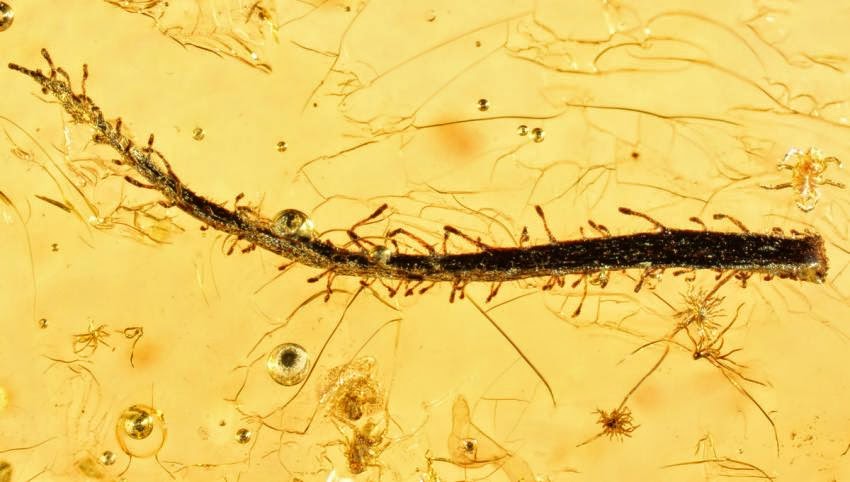
Researchers from the Universities of Göttingen and Bielefeld and the Botanical State Collection of Munich, led by paleontologist Professor Alexander Schmidt from the University of Göttingen, have found the world’s first fossils of a carnivorous flypaper trap plant. Both fossil leaves, covered with glandular hairs, are enclosed in a piece of Baltic amber. The amber comes from a mine near Kaliningrad in Russia and is about 35 to 47 million years old. So far, the fossil evidence of carnivorous plants was just of seeds and pollen belonging to the sundew family. The results were published in Proceedings of the National Academy of Sciences of the USA (PNAS).
Baltic amber is one of the world’s largest amber deposits and contains many inclusions of animals and plants. PhD student Eva-Maria Sadowski at the University of Göttingen examines these plant fossils in order to reconstruct the vanished Eocene flora. “The most striking features are the long-stalked multicellular glands, which are also called tentacles, covering the lower leaf surface and the margins of the leaf fossils,” says Eva-Maria Sadowski. These tentacles and other morphological details match the adhesive flypaper traps of the living carnivorous plant Roridula, today restricted to only a few places in South Africa. With their long sticky tentacles Roridula catches a large number of insects, but it does not produce enzymes for prey digestion, unlike most other carnivorous plants. However, heteropteran insects live in association with Roridula, and these bugs feed on the caught prey. To obtain additional nutrients, Roridula incorporates the nutrient-rich excretions of these bugs through their leaves. The highly efficient Roridula insect trap is organized into different tentacle size classes that were also detected in the fossil leaves. In addition, the micromorphology of their glandular heads and adhered organic remains indicate an adhesive flypaper trap.
These fossil flypaper traps provide insights into the evolutionary history of carnivorous plants. Originally, it was assumed that the ancestors of Roridula originated about 90 million years ago in Africa and evolved in isolation after the breakup of the southern continent Gondwana. “The new fossils from Baltic amber show that the ancestors of Roridula plants occurred in the northern hemisphere until 35 million years ago, and that they were not restricted to South Africa,” explains Prof. Alexander Schmidt. Roridula belongs to the plant family Roridulaceae and is related to the carnivorous American pitcher plants, the Sarraceniaceae. “Our results not only fill a gap in our knowledge about the historical distribution of the Roridulaceae, but also confirm molecular dating analyses, according to which the Roridulaceae exist as a distinct plant family for at least 38 million years,” says Dr. Andreas Fleischmann, carnivorous plant expert at the Botanical State Collection of Munich, who participated in the study. “Both carnivorous plant leaves from Baltic amber are important for understanding the evolutionary history and distribution of carnivorous plants. However, they also show us the high plant diversity of the Baltic amber forest, “says Eva-Maria Sadowski.
Reference:
Eva-Maria Sadowski et al. (2014). Carnivorous leaves from Baltic amber. Proceedings of the National Academy of Sciences of the USA. doi: 10.1073/pnas.1414777111.
Note : The above story is based on materials provided by University of Göttingen. The original article was written by Professor Alexander Schmidt & Eva-Maria Sadowski.










